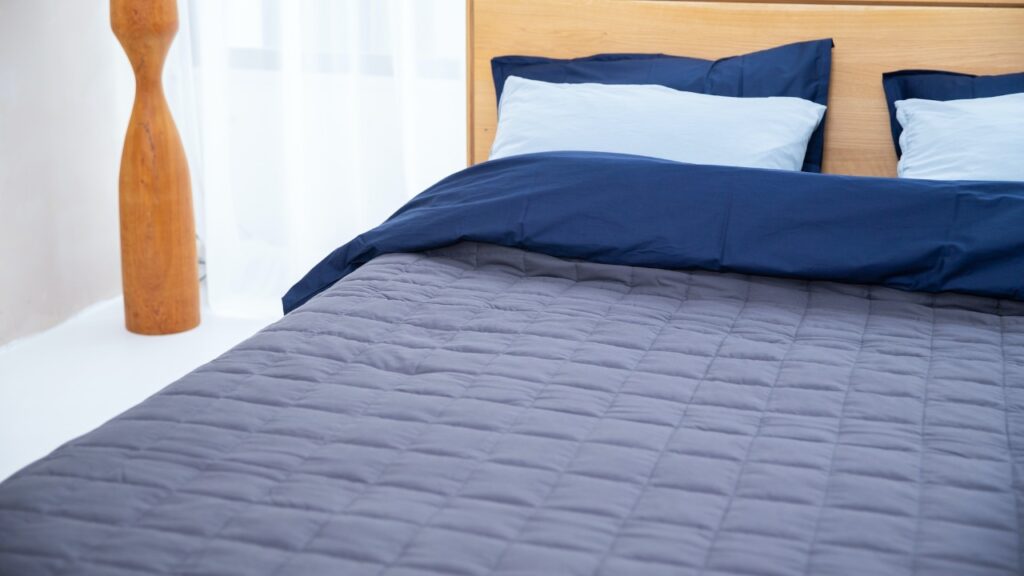Duvets and quilts are both popular bedding options, each with its unique characteristics and purposes. Understanding the differences between duvets and quilts can help you make the right choice for your bedroom. In this comprehensive guide, we will explore the distinctions between duvets and quilts, including their design, construction, functionality, and how to select the best option for your needs.
Duvets

A duvet is a soft, flat bag filled with down, feathers, or synthetic fibers, and it is encased in a removable cover. Duvets are known for their exceptional warmth and comfort. Here are the key characteristics of duvets:
Design:
Size: Duvets are available in various sizes to fit different bed dimensions, such as twin, full, queen, and king. They typically match the standard mattress sizes.
Coverage: Duvets are designed to fit inside a duvet cover, which acts as a protective and decorative outer layer. The duvet cover covers the mattress and box spring, and it extends over the sides of the bed, creating a neat and flowing look.
Closure: Duvet covers typically have a zippered or buttoned closure, which allows for easy insertion and removal of the duvet.
Color and Pattern: Duvet covers come in a wide range of colors, patterns, and designs. This allows for flexibility in changing the look of your bedding without replacing the entire duvet.
Construction:
Material: The filling of a duvet can be natural (down or feathers) or synthetic (polyester or microfiber). Natural fillings are known for their exceptional warmth and breathability.
Fill: Duvets are filled with a layer of insulation that provides warmth. The fill type and amount determine the duvet’s warmth level.
Stitching: Duvets are often constructed with baffle box or channel stitching to evenly distribute the filling and prevent it from clumping. This stitching ensures consistent warmth throughout the duvet.
Functionality:
Warmth: Duvets are renowned for their warmth and insulation. The fill provides excellent thermal properties, making duvets suitable for colder seasons and chilly nights.
Versatility: Duvets are versatile and can be used year-round. You can choose different duvet covers to adapt to changing seasons and interior decor.
Easy Care: Duvet covers are easy to clean and maintain. They are machine-washable, and the duvet itself may require less frequent washing due to the protection provided by the cover.
Quilts

Quilts are functional and often more versatile bedding options known for their warmth and craftsmanship. Here are the key characteristics of quilts:
Design:
Size: Quilts come in various sizes, including twin, full, queen, and king. They typically match the standard mattress sizes.
Coverage: Quilts are designed to cover the mattress and box spring, but they do not typically drape to the floor like duvets. They provide a neat and tailored look that complements the bed.
Hemming: Quilts often feature straight or scalloped hems, which contribute to their overall appearance.
Color and Pattern: Quilts are available in a wide range of colors and patterns. Many quilts are handmade or have a handcrafted appearance, which adds to their charm.
Construction:
Material: Quilts are usually made from multiple layers of fabric, including a top layer (often cotton or other natural fibers), a middle layer of batting (for warmth), and a backing fabric.
Fill: The batting or fill layer of a quilt is responsible for its warmth. Depending on the type and amount of batting used, quilts can provide varying levels of insulation.
Stitching: Quilts are known for their intricate stitching patterns. The top layer, batting, and backing are sewn together in a decorative and functional manner, often using a technique called quilting.
Functionality:
Warmth: Quilts are designed to provide warmth and insulation, making them a practical choice for colder seasons. The thickness and type of batting used in a quilt influence its warmth.
Layering: Quilts are often used as part of a layered bedding arrangement. They can serve as a middle layer between a decorative duvet or comforter and a fitted sheet.
Craftsmanship: Many quilts are handcrafted and showcase the artistry and skill of the maker. This craftsmanship can make quilts cherished heirlooms.
Seasonality: Quilts are versatile and can be used year-round. They provide warmth in the winter and can be used on their own or as an additional layer in the summer.
Selecting the Right Bedding Option
When deciding between a duvet and a quilt, consider the following factors:
Warmth: If you prioritize warmth and insulation, especially in colder seasons, a duvet is the better choice. Duvets filled with down or feathers are known for their exceptional warmth.
Versatility: If you prefer bedding that can adapt to changing seasons, a duvet with different duvet covers is a versatile option. You can easily switch duvet covers to suit your needs.
Craftsmanship: If you appreciate handcrafted or artisanal bedding and value the artistry of quilting, a quilt with intricate stitching and a handcrafted appearance may be more appealing.
Layering: If you prefer a layered bedding look, you can combine a quilt with a duvet or comforter. This allows you to enjoy both the warmth of a quilt and the decorative elements of a duvet.
Maintenance: Duvet covers are easy to clean and maintain. Quilts with intricate stitching may require more delicate care, as the stitching can be damaged in a standard washing machine.
Conclusion
The choice between a duvet and a quilt largely depends on your priorities regarding warmth, versatility, craftsmanship, and maintenance. Both duvets and quilts have their distinct roles in bedroom decor and functionality, and you can even use them together to create a layered, stylish, and cozy bedding arrangement. Ultimately, your choice should reflect your personal style, comfort needs, and the overall design of your bedroom.

